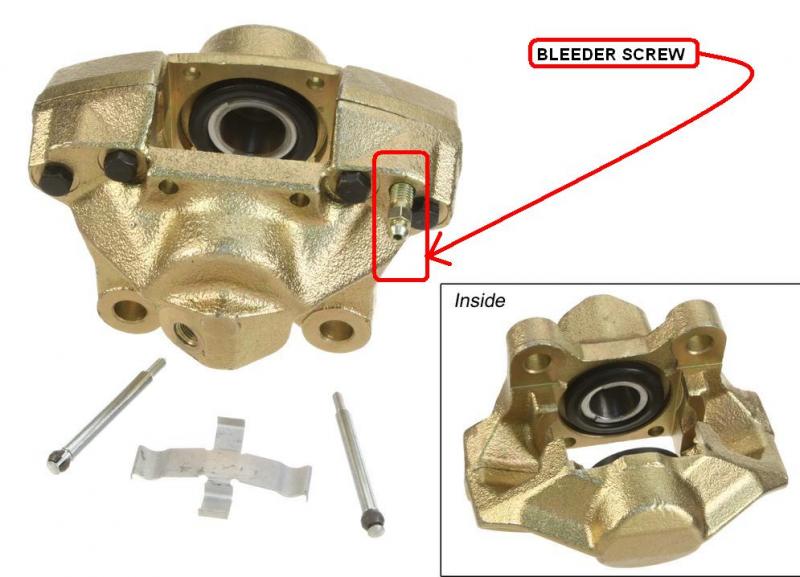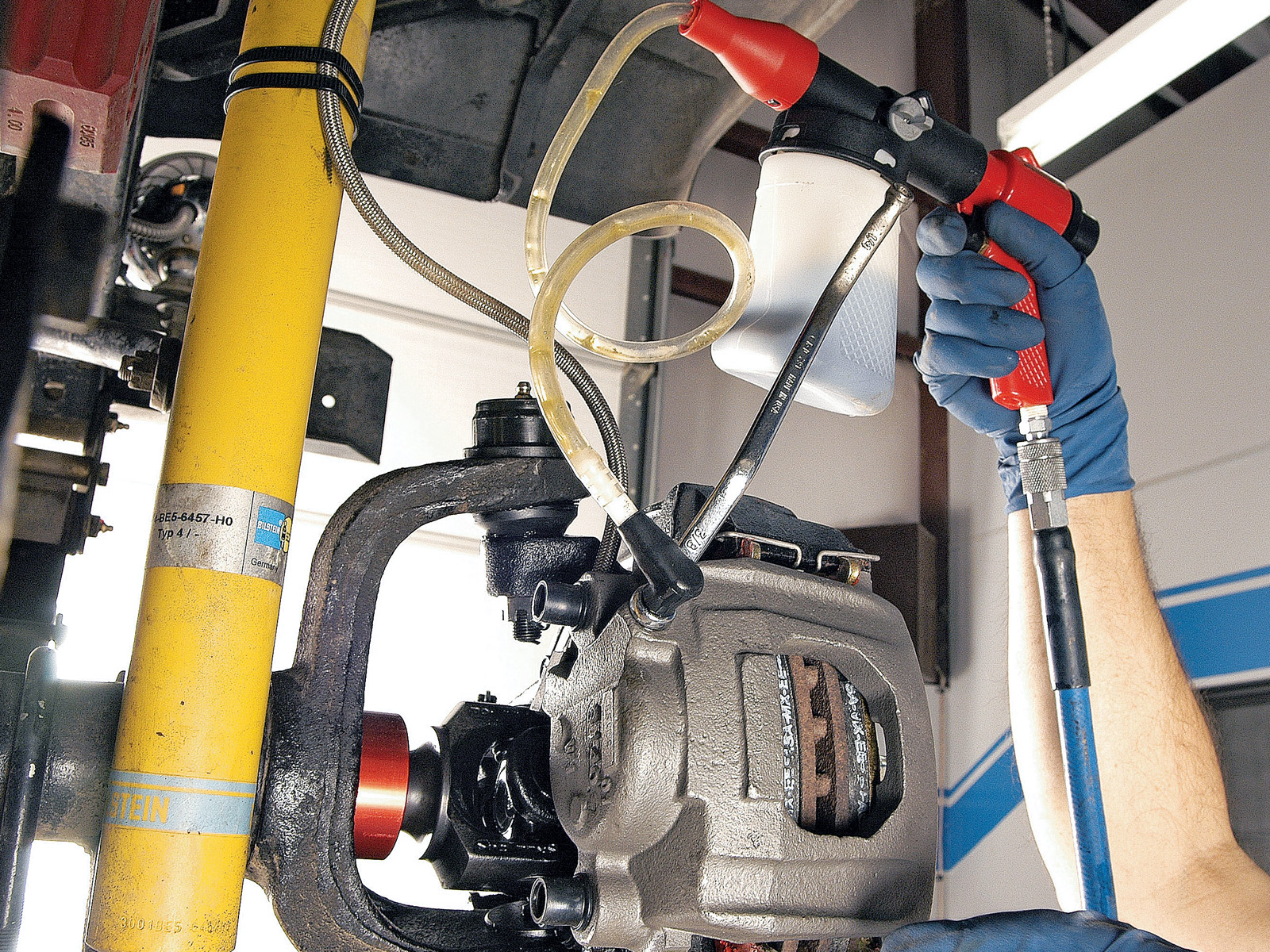All major manufacturer’s cars today have hydraulic brakes. What this means to you and me is that we must keep our car’s brake fluid in good condition – allowing the brakes to head up time and time again will break down the fluid in our brake lines. As brake fluid ages, it will begin to absorb contaminants, most namely water. Once you begin to really work the brakes, this contaminated fluid will begin to boil, will release gas, and you’ll experience what is know as “brake fade”, where your pedal will fill soft and spongy – not a good experience.
 Bleeding the brakes is a simple process, but normally requires two people. Two get started, you’re going to need a way to open the bleeder valve (but don’t open it just yet). Most of the time you’re just going to need a 6 point wrench so that you can break the bleeder lose on the back of the caliper. You want to make sure that you use the box end of the wrench so that you do not strip out the bleeder. If you are unfortunate enough to round of the ends of the bleeder then you’re going to have to go to the auto parts store to pick up a new one. These are very easy to install if you’re able to get the old one out. If not you’re going to have to replace the entire caliper so that you can go ahead and bleed the brakes.
Bleeding the brakes is a simple process, but normally requires two people. Two get started, you’re going to need a way to open the bleeder valve (but don’t open it just yet). Most of the time you’re just going to need a 6 point wrench so that you can break the bleeder lose on the back of the caliper. You want to make sure that you use the box end of the wrench so that you do not strip out the bleeder. If you are unfortunate enough to round of the ends of the bleeder then you’re going to have to go to the auto parts store to pick up a new one. These are very easy to install if you’re able to get the old one out. If not you’re going to have to replace the entire caliper so that you can go ahead and bleed the brakes.
The goal of bleeding your brakes is not only to replace all the old fluid with new, but also to get all of the air out of your lines. To do this you’ll need to bleed all four breaks on your vehicle. Start by removing the cap to master cylinder so that you can add more brake fluid when you need it. You can bleed the brakes of your vehicle one of two ways. The first way is to have two people, one person will be in a car manually pumping the brakes until they have a solid pedal, with the other person opening and closing the bleeder valve. The second way to bleed your brakes is with a vacum tool, a device with will use vacuum to either push or pull the fluid out for you, saving you quite a mess.
You also have to make sure that your vehicle does not have ABS or an anti-lock breaking system in your vehicle. If you have an anti-lock breaking system you’re going to have to bleed this system as well as the brakes themselves. Some models need a programmer for the ABS in order to make them work properly on your vehicle so pay close attention to what you’re doing otherwise you might have to take it into the shop to get it done.
 If you are bleeding the brakes yourself then you want to connect the vacuum tube to the bleeder on the caliper. Make sure that the bleeder is open so that you can start applying the vacuum to your breaking system. Once you get a continuous line of fluid coming through that side of the car it is time to move on to the next wheel. Then continue this process until you have a steady stream of fluid coming through all brake lines in your car. Each time that you take any amount of fluid from the reservoir you have to make sure that you fill a backup before you start on the next tire so that you do not end up sucking air through the lines again.
If you are bleeding the brakes yourself then you want to connect the vacuum tube to the bleeder on the caliper. Make sure that the bleeder is open so that you can start applying the vacuum to your breaking system. Once you get a continuous line of fluid coming through that side of the car it is time to move on to the next wheel. Then continue this process until you have a steady stream of fluid coming through all brake lines in your car. Each time that you take any amount of fluid from the reservoir you have to make sure that you fill a backup before you start on the next tire so that you do not end up sucking air through the lines again.
If you’re doing this process to two people than it is going to take a little bit more time because you constantly have to turn of the bleeder every time when the panel is hard to ensure that you get all the air out of the line. This can take up to 20 minutes per tire depending on how fast you’re willing to work. You’re also going to have to connect the hose that will allow the brake fluid to go into a canister every time you break a loose. You do not want brake fluid all over the floor when you’re bleeding the brakes because it can eat paint and other precious parts of your vehicle. You’ll want to person in the car to pump the brakes 5 or 6 times, then hold pressure on the brake pedal – the person near the wheel will open the bleeder valve, and fluid + air will come shooting out. The person in the car will feel the pedal go to the floor, and they will have to hold it there until the second person closes the bleeder, then repeat 5 to 10 times.
Make sure that you put the right type of brake fluid in your vehicle because there are different types that only work a certain vehicles. If you are unclear about the type of brake fluid that you should add to your vehicle then you can always refer to the owner’s Manual to get all the information you need on the brake fluid before you start bleeding your brakes.
Once you have all of this done to your breaking system you want to take some time to evaluate the brake lines in your vehicle. Sometimes you might have a small leak that will let air into the lines without you even knowing it every time you press the pedal. Take some time and do a visual inspection of the operating system of your vehicle when it comes your brakes because you have to be able to stop under any conditions. Take a look at your brake pads when you are bleeding your brakes because if they look worn down or do not have much pad left on them it is time to get them replaced as soon as possible.
